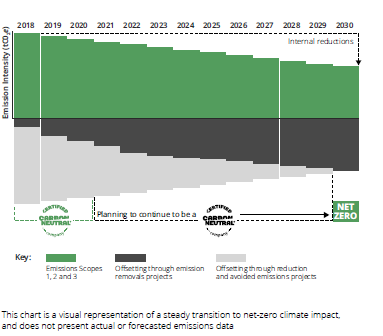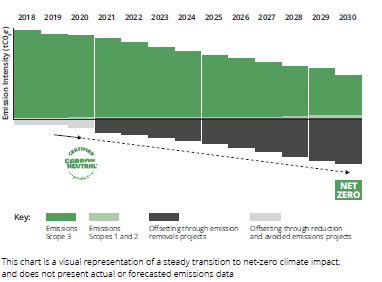Historically the terms carbon neutral and net zero have been interchangeable, but recently greater clarification on what net zero could and should mean has been published. This guidance provides an overview of the concept of net zero, and sets out three different ways in which CarbonNeutral® certifications support net zero objectives.
Net zero concept
Net zero is still a relatively new concept with approaches and definitions being published frequently (See Net zero in the Glossary for some of the latest definitions). We anticipate that definitions of net zero will be refined with time and application, and this guidance will be updated in subsequent revisions to the Protocol.
The rising prominence of net zero targets was initiated by The Intergovernmental Panel on Climate Change’s (IPCC) Special Report on Global Warming of 1.5˚C, which advised of the critical importance of achieving net-zero emissions as soon as possible to improve the probability of limiting warming to 1.5˚C. Adoption of net zero by the private sector is driven in large part by the desire to align with the ambition set out in the Paris Agreement of net zero emissions by or before 2050, and the growing number of nations which have refined their national climate plans to target the same.
2023 research by Climate Impact Partners into the Fortune Global 500 found that 40% (199) of companies have a net zero target, up from 39% (188) a year ago. Most targets are set for between 2031 and 2050 (33% of all companies), whereas 6% have set a net zero target to be achieved earlier. This compares to 7% (37) that are carbon neutral today, a further 10% (50) that have a target to be carbon neutral by 2030, and an additional 17% (87) that have a target to be carbon neutral by 2050.
How CarbonNeutral certifications support net zero ambitions
There are three main ways in which CarbonNeutral certifications support net zero ambitions:
1. Annual carbon accounting and action on all unabated emissions.
Defining and measuring carbon footprints on an annual basis and taking action on unabated emissions are processes that are common in carbon neutral programs and will be necessary for corporates achieving net zero. Carbon neutrality’s requirement to compensate for all unabated emissions through offsetting provides a reference price for GHG emissions that helps entities identify opportunities for deeper internal reductions. In addition to helping an individual organization become carbon neutral, offsetting unabated emissions to achieve a CarbonNeutral® certification finances emission reductions and transformation in the wider economy. The Science-Based Targets Initiative’s (SBTi) Beyond Value Chain Mitigation (BVCM) report, published in February 2024, recommends that organizations purchase carbon credits equal to at least 50% of unabated value chain emissions annually on the pathway to net zero to support global efforts to achieve net zero.
In 2024, the SBTi started work on version 2 of its Net Zero Standard, which is planned for release in 2025. It is expected to contain further guidance on the use of carbon credits in the context of achieving net zero.
We discuss the requirements of SBTi's BVCM on page 8 of our 2024 Climate Action Protocol.
2. Increasing removals.
For an organization to achieve a net zero target, unabated emissions are offset through removal projects, e.g. natural climate solutions such as protecting forests that remove carbon from the atmosphere (or “neutralisation measures” in SBTi’s language). To align CarbonNeutral® certifications with a net zero target, organizations must increase the proportion of removals in their offset portfolio until all unabated emissions are offset only with removal projects. Boston Consulting Group exemplifies this approach, with its commitment to steadily increase its portfolio of removal projects while achieving carbon neutrality, on the path to its net zero by 2030 target1. (see Figure 9).
During the transition to net zero, financing reductions and avoided emissions projects (“compensation measures in SBTi language) continues to play a “critical role in accelerating the transition to net-zero emissions at the global level. In addition, businesses are also increasingly looking for approaches that integrate climate action with other SDG impacts. Many avoidance and reduction projects deliver quantified impacts for sustainable development such as health and livelihoods, biodiversity conservation, and education. As a result, mixed portfolios of these projects, alongside removal projects which may not have the same level of SDG impact, can offer an optimal solution.
Figure 9: How CarbonNeutral certifications support net zero ambitions: Increasing removals

3. Increasing climate action on value chain emissions.
When an organization reaches net zero, it must cover all material sources of GHG emissions within its value chain. Through CarbonNeutral® product and service certifications, organizations are moving towards taking responsibility for all sources of emissions. For example, through CarbonNeutral® product certification, an organization may expand its carbon neutrality from operations towards a broader scope as part of its target to be net zero by 2030 (see Figure 10).
Figure 10: How CarbonNeutral certifications support net zero ambitions: using CarbonNeutral product certification to start taking climate action on entire value chain emissions

Further information can be found at:
Science Based Targets Initiative (SBTi), 2024, SBTi Corporate Net-Zero Standard,
https://sciencebasedtargets.org/resources/files/Net-Zero-Standard-Criteria.pdf
Science Based Targets Initiative (SBTi), 2021, Beyond Value Chain Mitigation FAQ,
https://sciencebasedtargets.org/resources/files/ Beyond-Value-Chain-Mitigation-FAQ.pdf
1 BCG, 2023, The First Three Years of BCG’s Net Zero Journey, https://www.bcg.com/publications/2023/the-first-three-years-of-bcgs-net-zero-journey.